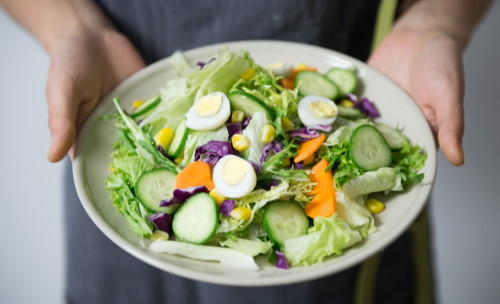What is the Volumetrics Diet, and why do you want it in your life? The Volumetrics Diet isn’t a new fad or a crazy difficult plan. It’s a straightforward plan that just makes sense for many people that allows you to eat more and weigh less, all while getting and staying healthy.
History of the Volumetrics Diet
How did such a quality diet plan come into being? It was initially conceived by Dr. Barbara Rolls, a Penn State University nutrition professor. She created a diet that is big on volume, so you feel full, yet it still creates a calorie deficit so you can lose weight. This helps people feel sated and not deprived, which is a big factor when it comes to sticking with a diet plan over the long term. And, says Dr. Rolls, long term is the name of the game.
BREAKING: New Natural Pill Melts Belly Fat
The Volumetrics Diet, Dr. Rolls explains, is not a fad, but something you can safely follow for life with weight loss and optimal health as benefits. As such, the Volumetrics Diet has been listed as one of the best diets in the U.S. News & World Report’s top 10 diet lists since 2011.
Rolls goes on to say that since there are no effective quick-fix diets and no pills that will perform miracles, it’s essential that people learn how to eat healthfully and make good decisions when it comes to food. And the Volumetrics Diet helps them do just that. It is designed to be educational and teach people how to make the right food choices as part of a lifelong commitment to fitness and health.
The Principles of the Volumetrics Diet
This diet is a little different than others in that you are able to eat a lot of food, but there are certain rules to follow. The diet is based on the premise that you most likely eat about the same volume of food each day when allowed to eat naturally.
So, the Volumetrics Diet cashes in on the fact that if you make up the bulk of that food with high water content and fibrous food choices, you’ll feel like you ate a lot but the caloric value will not add up to what it normally would. Add to that the fact that there are no restrictions, only suggested moderation, and it may lead to fat loss for many.
Here are the simple rules:
- You’ll have three meals and two snacks a day.
- Stay within your daily calorie allotment (which should be a deficit of between 500 and 1,000 calories a day to lose weight).
- Eat according to Category rules: Category 1 foods are selected to give you a lot of volume at a very low caloric cost. You’ll eat the most liberally from Category 1, moderate amounts from Category 2, small amounts from Category 3, and rarely from Category 4.
- You’re encouraged to exercise for at least 30 to 60 minutes per day.
- Track your food intake and physical activity, so you can monitor your progress and see where you could improve.
This is how the categories break out:
Category I: Very Low-Density Foods (to eat liberally)
This category includes soups made with broth, skim milk and non-fat yogurt, fibrous veggies like broccoli, cauliflower, zucchini, and kale, and very low starch fruits like berries, melon, and stone fruits. You can wash down meals with water, unsweetened tea, and black coffee.
Category II: Low Density Foods (to enjoy moderately)
This category is comprised of starchy fruits and vegetables (like potatoes, peas, and corn), low-fat milk products, whole grain foods (such as quinoa, couscous, buckwheat, brown rice), beans, lean proteins like skinless chicken or turkey, very lean cuts of beef, low fat white fish.
Category III: Medium Density Foods (to watch closely and keep portion sizes in check)
Foods in this group should be eaten in smaller portions and include items like higher fat meats (e.g., poultry with skin, fatty fish), cheeses and other full-fat milk products, breads and baked items made with refined grains (white bread, white rice, pasta, crackers, etc.), and higher calorie condiments.
Category IV: High Density Foods (to mostly avoid)
Lastly, food in this category should be few and far between as they are the highest calorie of the group. As mentioned, no foods are restricted but it’s best to indulge sparingly in this category as it includes chips and crackers, candies and desserts, and processed foods as well as refined oils (like margarine and vegetable oil). This category also includes high-fat items that can be healthier like peanut butter, olive oil, butter, and nuts and seeds.
Benefits of the Volumetrics Diet
Besides the fact that you’ll likely easily lose weight over time, and it won’t be that hard to do, the Volumetrics Diet also boasts some other great positives.
Healthy foods—you’ll choose from an endless variety of whole, nutritious natural foods that will fill in common nutritional gaps and give you plenty of energy.
Easy to follow—it’s not complex. The diet is broken down into four simple categories.
No foods are restricted—you don’t have to stop living your life. Because you can choose your foods and are not restricted to limited choices, you can live your life and still lose weight.
Nutritionally complete and considered to be safe—choosing from a variety of healthy foods helps you get the nutrition you need. And because there are no restricted food groups, you won’t find your body craving nutrients the way you would when you cut out entire food groups.
Promotes both long-term and short-term weight loss—yes, you’ll probably lose weight rather quickly at the outset of the diet, but more importantly, you’ll continue to lose and then maintain weight over time as you entwine the diet plan into your lifestyle.
It’s a program designed to help manage diabetes and promote overall health—this plan also promotes overall improved health and helps you manage common health issues that come with age and weight gain.
Drawbacks of the Volumetrics Diet
While there are many positives to the Volumetrics Diet, no diet is for everyone. And the Volumetrics Diet does have some drawbacks. Namely, there are some restrictions for even healthy foods. And it can also be time-intensive to create the recipes and meals as most meals and snacks are supposed to be made at home in your own kitchen.
There are also limited resources for people following this diet with few recipe guides, support groups, or apps. Instead, you may need to buy Dr. Roll’s book to understand how to calculate the calorie density of meals as well as how to best track your food intake.
Because the diet is low in fat, it also limits healthy fats, including those in nuts, seeds, avocados, and quality oils like olive, which are encouraged on other healthy yet flexible diets like the Mediterranean Diet, the Mind Diet, and a high-protein diet.
Finally, because of its strong emphasis on cutting calories, some people will avoid eating high-calorie yet nutrient-dense foods like whole eggs or avocados and choose processed low-calorie foods like processed fat-free salad dressings or other “diet” foods instead. This can be problematic as sugars and artificial chemicals are often added to low-calorie foods to make them more palatable. Low calorie, that is, does not always translate to healthy.
Volumetric Diet: Recap
TRENDING: Fix Toenail Fungus With This Simple Trick
When combined with a solid exercise routine and plenty of water, the Volumetrics Diet can be helpful for many people who want to lose weight over the long-term by reducing calories and hunger. Because it’s high in nutrient-dense foods, including lots of vegetables and fruits, it can also help people dramatically improve diet quality.
Like any diet, though, it does have some drawbacks, including restricting some foods that are healthy and highly satiating despite their higher calorie or fat count.








